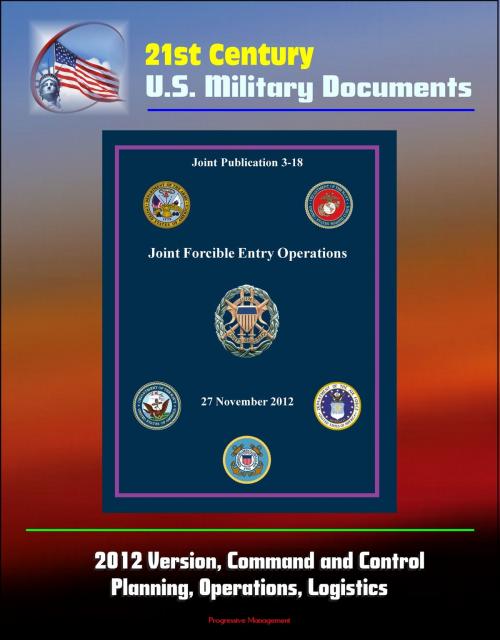21st Century U.S. Military Documents: Joint Forcible Entry Operations (Joint Publication 3-18) - 2012 Version, Command and Control, Planning, Operations, Logistics
Nonfiction, History, Military, United States| Author: | Progressive Management | ISBN: | 9781301535941 |
| Publisher: | Progressive Management | Publication: | September 14, 2013 |
| Imprint: | Smashwords Edition | Language: | English |
| Author: | Progressive Management |
| ISBN: | 9781301535941 |
| Publisher: | Progressive Management |
| Publication: | September 14, 2013 |
| Imprint: | Smashwords Edition |
| Language: | English |
This publication provides joint doctrine for planning, executing, and assessing joint forcible entry operations., which seize and hold lodgments against armed opposition. A lodgment is a designated area in a hostile or potentially hostile operational area that, when seized and held, makes the continuous landing of troops and materiel possible and provides maneuver space for subsequent operations (a lodgment may be an airhead, a beachhead, or a combination thereof). Forcible entry demands careful planning and thorough preparation; synchronized, violent, and rapid execution; and leader initiative at every level to deal with friction, chance, and opportunity.
United States National Military Strategy and Joint Forcible Entry Operations - To be credible both as a deterrent and as a viable military option for policy enforcement, the Armed Forces of the US must be capable of deploying and fighting to gain access to geographical areas controlled by forces hostile to US interests. Swift and decisive victory in these cases requires forcible entry and the ability to surge follow-on forces.
Principles for Forcible Entry Operational Success - The principles of forcible entry are: achieve surprise, control of the air, control of space, electromagnetic spectrum management, operations in the information environment, sea control, isolate the lodgment, gain and maintain access, neutralize enemy forces within the lodgment, expand the lodgment, manage the impact of environmental factors, and integrate supporting operations.
EXECUTIVE SUMMARY * CHAPTER I - INTRODUCTION * Forcible Entry * United States National Military Strategy and Joint Forcible Entry Operations * Principles for Forcible Entry Operational Success * Operational Applications of Forcible Entry Operations * Forcible Entry Capabilities * Multinational Considerations * CHAPTER II - COMMAND AND CONTROL * Purpose * Force Employment * Organization of the Forcible Entry Operational Area * Command Relationship for Forcible Operations * Airspace Control * Air Defense Command and Control * Communications * Rules of Engagement * Friendly Fire Prevention * CHAPTER III - PLANNING * Purpose * Forcible Entry and the Joint Planning Process * Forcible Entry Planning Considerations * CHAPTER IV - OPERATIONS * Purpose * Section A. Integration and Synchronization * Introduction * Forcible Entry Operations Phases * Integration and/or Synchronization Considerations * Section B. Supporting operations * Special Operations Forces * Fires * Intelligence Support and Considerations * Information Operations * Chemical, Biological, Radiological, and Nuclear Considerations * CHAPTER V - LOGISTICS * General * Specific Logistic Considerations for Supporting Forcible Entry Operations * APPENDIX * A - Amphibious Assault Operations * B - Airborne and Air Assault Operations * C - References * GLOSSARY * Part I - Abbreviations and Acronyms * Part II - Terms and Definitions
This publication provides joint doctrine for planning, executing, and assessing joint forcible entry operations., which seize and hold lodgments against armed opposition. A lodgment is a designated area in a hostile or potentially hostile operational area that, when seized and held, makes the continuous landing of troops and materiel possible and provides maneuver space for subsequent operations (a lodgment may be an airhead, a beachhead, or a combination thereof). Forcible entry demands careful planning and thorough preparation; synchronized, violent, and rapid execution; and leader initiative at every level to deal with friction, chance, and opportunity.
United States National Military Strategy and Joint Forcible Entry Operations - To be credible both as a deterrent and as a viable military option for policy enforcement, the Armed Forces of the US must be capable of deploying and fighting to gain access to geographical areas controlled by forces hostile to US interests. Swift and decisive victory in these cases requires forcible entry and the ability to surge follow-on forces.
Principles for Forcible Entry Operational Success - The principles of forcible entry are: achieve surprise, control of the air, control of space, electromagnetic spectrum management, operations in the information environment, sea control, isolate the lodgment, gain and maintain access, neutralize enemy forces within the lodgment, expand the lodgment, manage the impact of environmental factors, and integrate supporting operations.
EXECUTIVE SUMMARY * CHAPTER I - INTRODUCTION * Forcible Entry * United States National Military Strategy and Joint Forcible Entry Operations * Principles for Forcible Entry Operational Success * Operational Applications of Forcible Entry Operations * Forcible Entry Capabilities * Multinational Considerations * CHAPTER II - COMMAND AND CONTROL * Purpose * Force Employment * Organization of the Forcible Entry Operational Area * Command Relationship for Forcible Operations * Airspace Control * Air Defense Command and Control * Communications * Rules of Engagement * Friendly Fire Prevention * CHAPTER III - PLANNING * Purpose * Forcible Entry and the Joint Planning Process * Forcible Entry Planning Considerations * CHAPTER IV - OPERATIONS * Purpose * Section A. Integration and Synchronization * Introduction * Forcible Entry Operations Phases * Integration and/or Synchronization Considerations * Section B. Supporting operations * Special Operations Forces * Fires * Intelligence Support and Considerations * Information Operations * Chemical, Biological, Radiological, and Nuclear Considerations * CHAPTER V - LOGISTICS * General * Specific Logistic Considerations for Supporting Forcible Entry Operations * APPENDIX * A - Amphibious Assault Operations * B - Airborne and Air Assault Operations * C - References * GLOSSARY * Part I - Abbreviations and Acronyms * Part II - Terms and Definitions















